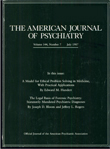Attentional impairments in deficit and nondeficit forms of schizophrenia
Abstract
OBJECTIVE: Previous studies of attention/information processing impairments in schizophrenia suggest that patients with the deficit syndrome should be characterized by impaired performance on measures of visual information processing. Therefore, the authors examined whether two measures of visual information processing, a degraded stimulus version of the continuous performance test and a forced choice span of apprehension task, were uniquely related to the deficit syndrome. METHOD: Performance on the continuous performance test and span of apprehension task was examined in 20 deficit and 56 nondeficit patients with schizophrenia and in 27 subjects in a normal comparison group. RESULTS: Deficit patients performed significantly less well than both nondeficit patients and the normal comparison group on the continuous performance test and span of apprehension task. There were no significant differences between the nondeficit patients and the normal group on the continuous performance test, but nondeficit patients performed significantly less well on the span of apprehension task than the normal group. Differences between the deficit and nondeficit patients in performance on the continuous performance test and span of apprehension task were not related to total scores on the Brief Psychiatric Rating Scale factor 1 or on the Thought, Language, and Communication scale or to neuroleptic level. CONCLUSIONS: The results suggest that deficit patients are uniquely characterized by impaired performance on the continuous performance test. The deficit patients' differential performance on the continuous performance test may be related to either an inability to activate and allocate attention or an impairment in the perceptual organization of visual information.



